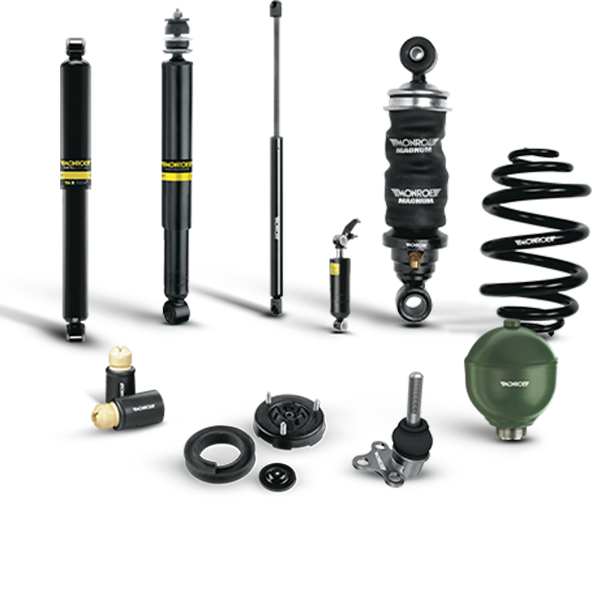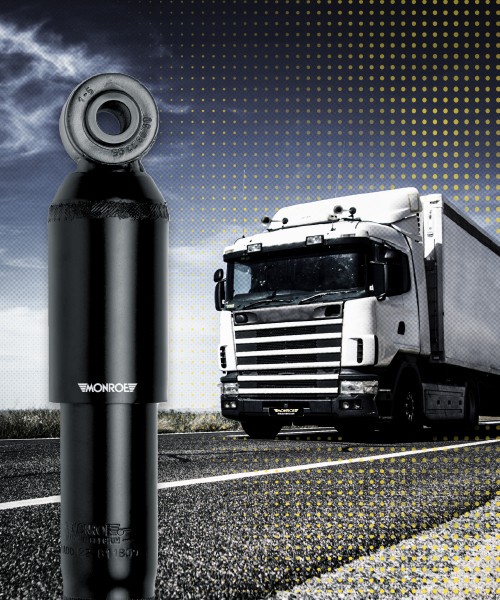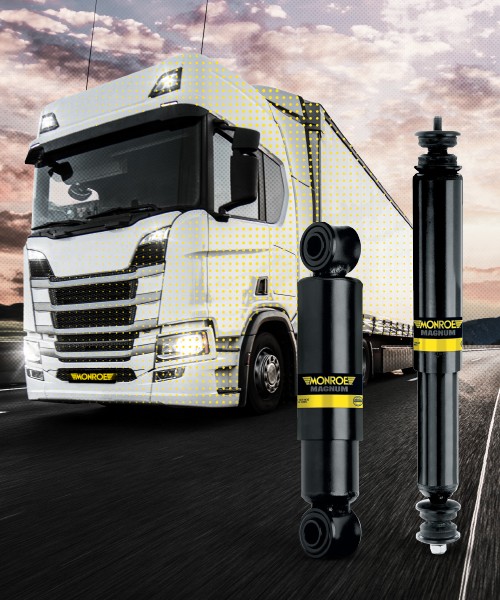Here’s How Replacing Worn Shock Absorbers Can Help Protect Your Commercial Vehicle Investment

Your commercial vehicles work hard, and they should – after all, they represent a sizeable investment in your business. But these trucks, trailers, delivery vans and other CVs can only contribute to your bottom line when they are on the job. When they are in the service bay for replacement of air suspension components, brakes, tires, springs and other parts, they are little more than a significant operating expense – one that can be reduced with a wise approach to preventive maintenance.
One of the most commonly overlooked yet important maintenance needs is the replacement of worn shock absorbers. In truth, these relatively inexpensive components can have a profound effect on the durability of other, more costly, parts and systems.
What shock absorbers really do
Let’s begin with a review of what commercial vehicle shocks actually do. They are not simply designed to “absorb” road shocks, but also to:
- Control wheel movement: Maintaining a firm “grip” on the road is key to vehicle safety. Shocks help keep the vehicle’s tires firmly planted on the road by limiting the wheels’ tendency to rebound away from potholes and other uneven surfaces. When shocks are worn, they can lose this capability, leading not only to reduced traction but also potentially increased wear of other, more expensive, components.
- Protect tires, springs and air suspensions: When it comes to those “other” components, the durability of tires, springs, air suspension parts and steering linkage components can be severely reduced by the use of worn shocks. For example, one of the most common forms of premature tire wear is “cupping,” or the presence of high and low spots in the tread. Cupping is caused by excessive up-and-down motion or vibration of the tire – a condition that is far less likely to occur with properly functioning shock absorbers.
Here’s another example: Premature wear of air springs is often caused by overextension of the air bag or bellow due to a deep pothole, contact with a curb or other severe impact. Shocks act as a vital suspension limiter, so a properly operating shock can help prevent this damage. A worn shock, by contrast, could cause an unwanted and expensive trip to the service bay.
Also consider that as vehicle vibration increases, a variety of truck and trailer electronics can be at risk. Lamps and wiring connections, for example, can be extremely susceptible to vibration and road impacts. Your cargo could be damaged or destroyed as well.
- Reduce braking distance: Think about all the money you invest in brake pads, discs, linings and drums for your commercial vehicles. Now consider that even brand-new brake components often cannot properly perform their jobs when your vehicles’ tires have lost contact with the road surface. Therefore, brake performance – and particularly stopping distance – can be impacted by the presence of worn shocks. In addition, worn shocks can actually increase brake wear on the front wheels by permitting excessive weight transfer from the rear to the front of the vehicle.
- Increase driver comfort and confidence: Good drivers are hard to find – and often even harder to keep. Many drivers prefer to operate vehicles that are well maintained and easier to control in a full range of operating environments. Because new shock absorbers can help improve tire-to-road contact, they can also reduce the need for drivers to continually correct the vehicle’s steering path in order to stay in the lane and/or ensure proper stability. If you want your drivers to feel comfortable and confident on the job, be sure their vehicles’ shocks are in good operating condition.
- Reduce cost-per-kilometer: Given that shocks help protect a variety of other safety-intensive components, they can help reduce the operating cost-per-kilometer of your commercial vehicles. Remember that shocks are comparatively inexpensive vs. air springs and other components. They’re also relatively easy to inspect and replace. Bottom line, when your vehicles are riding on properly functioning shocks, they can spend more time on the job and less time costing you money in the service bay.
Why shocks wear out
Now that we understand the risks of riding on worn shock absorbers, let’s examine how and why these important safety components wear out.
For starters, consider the punishing daily demands placed on a commercial vehicle shock: It has been estimated that a shock absorber is required to provide an average of 1,087 stabilizing actions – meaning compression and/or rebound – per kilometer of operation. For a commercial vehicle traveling 20,000 km per year, that’s 22 million stabilizing actions. For 80,000km, it’s 88 million stabilizing actions.
The sheer mechanical demands on a shock are enormous – matched perhaps only by your vehicles’ tires.
Conventional shock absorbers provide these stabilizing, or damping, actions through the movement of internal hydraulic fluid through precisely designed valves. In addition to everyday mechanical wear on shock components – the metal, rubber and plastic parts that are subjected to extreme temperatures and a wide range of mechanical loads – this internal fluid eventually loses viscosity and elasticity. This, in turn, reduces damping performance. Don’t assume, therefore, that your vehicles’ shocks are in good operation condition based simply on a visual inspection. A qualified repair technician understands how to properly determine the condition of shocks, including checking their temperature at the end of a trip. A warm shock indicates the unit is performing its job – increased temperature represents the energy dissipated by the shock’s damping actions. A cold shock might indicate the shock is no longer performing this important function. A good rule of thumb is to inspect shock absorbers every 20,000 km and replace them every 80,000 km.

Go farther with Monroe® Magnum shocks
Monroe Magnum commercial vehicle shocks are the overwhelming choice of many leading fleets worldwide. Why? Because these precisely engineered, highly robust shocks are engineered to help customers improve vehicle safety, performance and reliability. They can reduce the amount of time your vehicles spend in the service bay. And they can help keep their drivers safe, confident, comfortable and satisfied.
Each Monroe Magnum axle shock begins with premium materials proven to offer long life in the most demanding operating conditions. Plus, each shock includes a high-temperature resistant sealing system and premium, single-bonded bushing for exceptional durability.
The content contained in this article is for informational purposes only and should not be used in lieu of seeking professional advice from a certified technician or mechanic. We encourage you to consult with a certified technician or mechanic if you have specific questions or concerns relating to any of the topics covered herein. Under no circumstances will we be liable for any loss or damage caused by your reliance on any content.
other articles that might interest you
discover the monroe range
Monroe offers a total steering & suspension solution for vehicles. Discover our shock absorbers, mounting and protection kits, gas springs, coil springs, spheres
and many other steering & suspension parts.


